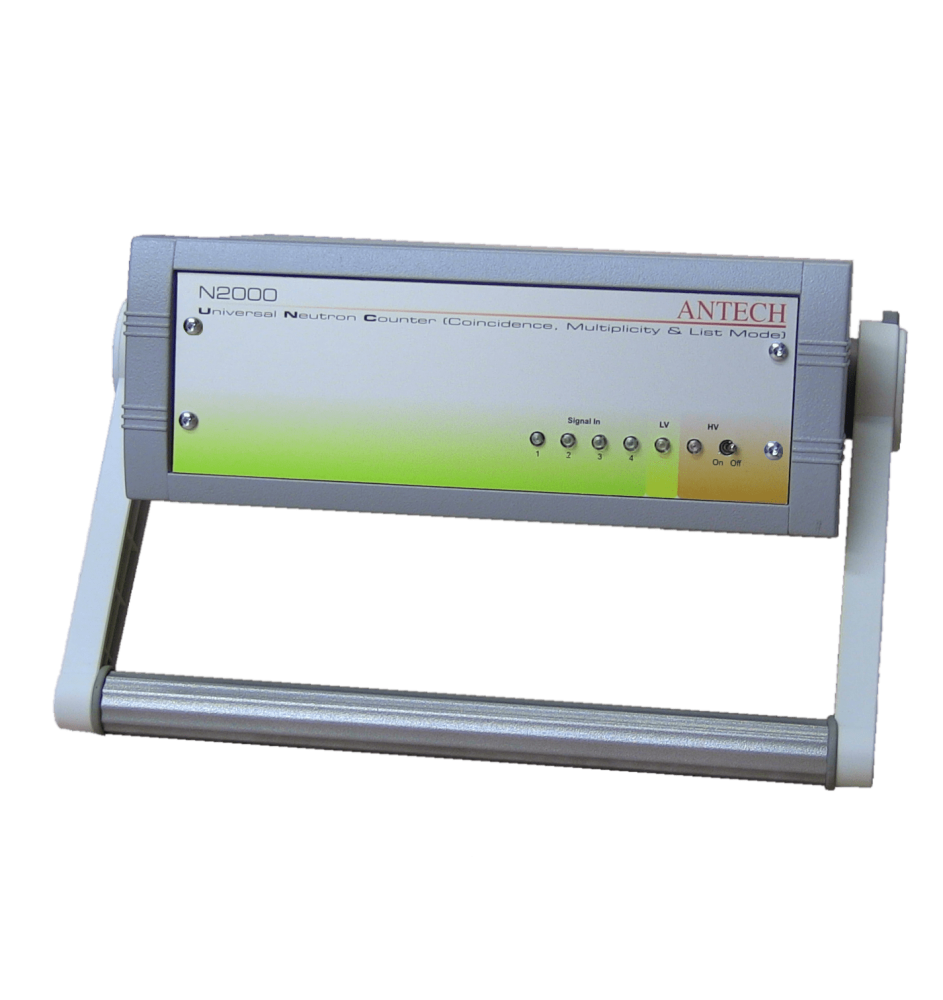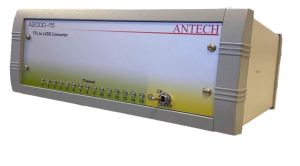The ANTECH Universal Neutron Counter N2000 has been designed to provide a state of the art neutron counting capability for nuclear safeguards, waste assay and accounting measurements for special nuclear materials. The unit incorporates total neutron counting, shift register neutron coincidence counting, neutron multiplicity counting, and list mode neutron data acquisition. It is compatible with all ANTECH neutron counting instruments and it can be employed to upgrade the electronic counting and data acquisition component of most neutron measurement systems used for safeguards and waste assay.
The ANTECH N2000 can be deployed in a variety of configurations including rack mounting and it can be integrated into existing systems as an upgrade providing enhanced neutron counting capability. The neutron data generated by the unit is compatible with most neutron counting and analysis software codes.
- Simultaneous neutron totals, coincidence, multiplicity counting and list mode (time stamping) acquisition
- Compact portable design
- Virtual Instrument design: various pulse train analysis techniques are possible with real-time software
- Fully compatible with INCC and ANTECH MasterPassiveActive software
- Reduction of system dead-time through embedded pulse mixer with multiple inputs (software controllable enable/disable): 4 TTL and up to 15 LVDS
- Powered via 12 Vdc mains adaptor
Benefits
- High frequency 40 MHz acquisition clock for improved accuracy and backward compatibility with older systems that use 4MHz clocks
- 19 high count rate inputs: 4TTL (BNC) and 15 LVDS (D-sub 37) — up to 40MHz
- User selectable Fast Accidentals sampling (4 MHz clock) mode
- Proprietary data compression technique for time stamping information allowing very high count rates while minimising disk space requirements
- High Voltage supply for ³He neutron detectors—max 2000 Vdc
- Low voltage 5 Vdc supply for a maximum of 1 8 amplifier boards via front-panel BNC connector
- Gate Out connector (BNC) to signal when the unit is effectively counting (used for synchronizing multiple units)
- I/O connector (BNC) can be defined by the user to be an input or an output. When used as an input it can be used to start/stop an acquisition. When configured as an output it may be used to signal the end of a measurement or to trigger an alarm (for instance when a certain count rate occurs)
- The operator can select which inputs contribute to the coincidence count and which don’t. All inputs also function as a scaler (a simple pulse counter)
- Each input has an input inhibit function. When enabled, input is disabled for a fixed time after an incoming pulse
Features
-
Description
The ANTECH Universal Neutron Counter 2000 Series combines Total Neutron Counting, Shift Register Coincidence Counting, Multiplicity Counting and List Mode (LM) data acquisition in a single portable package to provide a state of the art instrument. With this new Virtual Instrument (VI) it is not necessary to choose between neutron multiplicity counting or list mode pulse acquisition for a safeguards inspection in the field. The 2000 Series combines the benefits of both measurement techniques; immediate measurement results are provided by the Virtual Instrument (VI) real-time soft-ware, while the time stamping information saved on a hard disk can be re-analysed as necessary. The acquired pulse train can be analysed with future techniques or improved instrument parameters.
The unit has a maximum of 19 inputs, which provide at least one input per amplifier board for the small to medium detector systems. The use of Low Voltage Differential Signaling (LVDS) with twisted wire ribbon cable (a round shielded cable is also available) provides an effective solution for sending pulses from amplifier board outputs to instrument inputs. A single D-sub connector provides signal and 5Vdc power supply connections. For this purpose a special interface board must be embedded in the junction box of a neutron detector for TTL to LVDS level conversion. For example, up-grading a standard Active Well Coincidence Counter with LVDS signaling dramatically reduces system dead time and improves the detection of faulty amplifiers or counter 3He tubes.
-
Specifications
Weight




